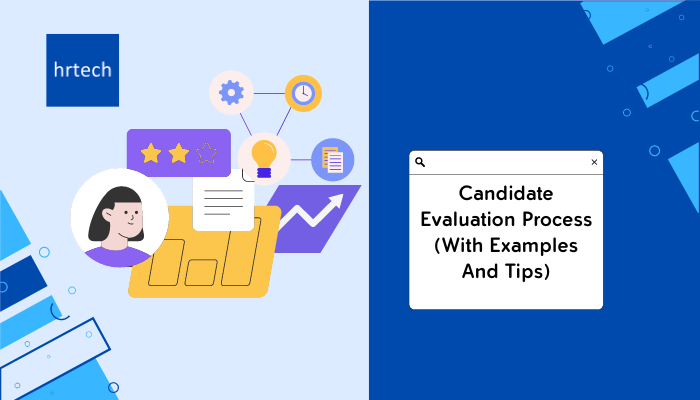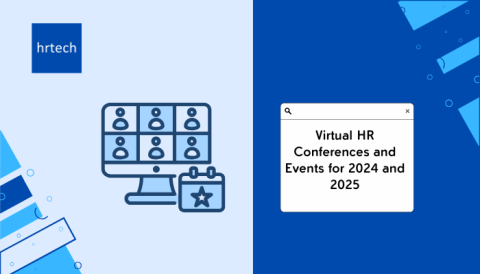To build a successful team, you need to hire the top talent. That’s why having a solid candidate evaluation process becomes important.
In this guide, we break down all the processes involved in candidate evaluation from start to finish, providing several examples and tips. Keep reading to explore more.
What Is Candidate Evaluation?
Candidate evaluation is the process of reviewing job applicants to figure out if they are a good fit for a specific job.
It involves looking at resumes, doing interviews, and using different tests to learn about candidates’ skills, experience, and how well they might fit in with the company.
Here are some examples of candidate evaluation methods:
- Looking at resumes to find candidates who meet the basic requirements for the job.
- Doing phone interviews to see how well candidates communicate and if they might be a good fit.
- Having in-person interviews to learn more about candidates’ qualifications and experience.
- Assessments to see how well candidates can do specific tasks or solve problems.
Why Does Candidate Evaluation Matter?
Candidate evaluation is crucial because it helps companies make good hiring choices.
When companies carefully look at candidates, they can:
- Find the best people for the job who have the right skills, experience, and potential to do well.
- Keep people from quitting by hiring candidates who will be happy with the job and stay longer.
- Help teams work better by choosing candidates who fit in well with the team and the company culture.
Now that you’ve got a brief overview of candidate evaluation, let’s jump right in and take a look at the exact candidate evaluation process.
Candidate Evaluation Process
The candidate evaluation process is a systematic approach to assess job applicants and choose the best person for the job.
It starts with looking at resumes and doing initial interviews, then moves on to more detailed interviews and assessments, and ends with a final evaluation and decision.
1. Pre-Screening And Initial Interview
Pre-screening is the first step in the candidate evaluation process. It involves looking at resumes and applications to see if candidates meet the basic requirements for the job. This helps narrow down the list of candidates to those who are most qualified.
Examples of pre-screening methods:
- Use an applicant tracking system like JazzHR, Greenhouse, or iCIMS to automatically screen resumes for keywords and qualifications
- Have candidates answer a set of questions about their skills and experience when they apply, such as “How many years of experience do you have in this field?” or “What is your proficiency level with Microsoft Excel?”
- Do short phone interviews to ask basic questions and get a sense of the candidate’s communication skills, such as “Tell me about your experience with project management” or “Why are you interested in this role?”
Tips for effective pre-screening:
- Make a list of must-have qualifications and skills for the job to use as a checklist when reviewing resumes.
- Use the same pre-screening process for all candidates to be fair and consistent, such as using the same set of questions for all phone screens.
- Don’t rely too much on keywords in resumes – look at the whole picture of the candidate’s experience and skills, and consider transferable skills that may be relevant to the role.
2. The Main Interview Process
The main interview process is a crucial part of candidate evaluation. It usually involves several different types of interviews and assessments to get a well-rounded view of each candidate.
Examples of interview types and questions to ask:
- Phone interviews to ask more detailed questions and assess communication skills, such as “Describe a time when you had to handle a difficult customer. How did you resolve the situation?”
- In-person interviews with the hiring manager and other team members to evaluate fit and qualifications, such as “What are your strengths and weaknesses?” or “How do you handle stress and tight deadlines?”
- Panel interviews with several interviewers to get multiple perspectives on the candidate, such as “Tell us about a project you led from start to finish. What challenges did you face and how did you overcome them?”
- Skill assessments or job simulations to see how the candidate would perform in the role such as a coding challenge for a software developer.
Tips for a successful interview process:
- Train interviewers on how to ask good questions and evaluate candidates fairly.
- Take notes during interviews and use a scoring system to evaluate candidates consistently, such as rating each answer on a scale of 1-5 based on how well it demonstrates the desired skills and qualities for the role.
3. Post Interview Evaluation And Decision Making
After all the interviews are done, it’s time to evaluate the candidates and make a hiring decision. Using candidate assessment software during this stage can help you quickly compare candidates based on standardized metrics and remove any biases from the decision-making process. This involves comparing notes from the interviews, discussing the strengths and weaknesses of each candidate, and choosing the person who best fits the job requirements and company culture.
Examples of post-interview evaluation methods:
- Have each interviewer fill out a candidate evaluation form with ratings and comments, such as scoring the candidate’s technical skills, communication abilities, and cultural fit on a scale of 1-5.
- Meet as a group to discuss the candidates and share feedback, focusing on specific examples and evidence from the interviews rather than just general impressions.
- Use a weighted scoring system to rank the candidates based on key criteria, such as giving double weight to the most important skills or qualities for the role.
Tips for effective post-interview evaluation and decision-making:
- Review your notes and evaluation forms soon after each interview while the details are still fresh, and share them with the rest of the hiring team.
- Consider not just the candidate’s skills and experience, but also their potential for growth and fit with the team, such as their ability to learn quickly or work collaboratively.
How To Create A Candidate Evaluation Form?
A candidate evaluation form helps in assessing job applicants’ qualifications, skills, and fit for a role. It helps ensure a fair and consistent evaluation process across all candidates.
Key Elements of a Candidate Evaluation Form
- Job requirements and qualifications
- Scoring system (e.g., 1-5 scale or pass/fail)
- Assessment criteria (e.g., skills, experience, education)
- Interview questions and notes section
- Overall recommendation and next steps
Tips for Creating and Using a Candidate Evaluation Form
- Align the form with the job description and requirements.
- Use a simple but thorough scoring system.
- Include all types of assessment criteria.
- Leave space for notes and observations during interviews
- Involve multiple evaluators to reduce bias.
- Use the form consistently for all candidates.
- Review and update the form regularly based on feedback and outcomes.
With well-designed candidate evaluation forms, you can make better and more informed hiring decisions.
Pro-Tip: Here’s a complete guide on the latest talent acquisition and hiring trends. Take a look if you’re interested in keeping yourself updated with the latest trends in the industry.
Evaluating Key Competencies And Skills
When assessing candidates, focus on the core competencies and skills needed for the role. These may include:
- Technical skills (e.g., software proficiency, industry knowledge)
- Soft skills (e.g., communication, teamwork, adaptability)
- Problem-solving and critical thinking abilities
- Leadership potential and management experience
Use a mix of different methods to evaluate these competencies, such as:
- Behavioral interview questions
- Work samples and case studies
- Skills assessments and tests
- Reference checks and background verification
For instance, when hiring a financial analyst, key competencies may include:
- Financial modeling and analysis skills
- Proficiency in Excel and other relevant software
- Attention to detail and accuracy
- Ability to communicate complex information clearly
Focusing on these essential competencies helps you spot candidates with the highest potential for success.
Ensuring Fair And Transparent Evaluation
To maintain a fair and unbiased evaluation process:
- Use standardized criteria and scoring rubrics.
- Train interviewers on unconscious bias and objective assessment.
- Include diverse perspectives in the evaluation process.
- Document all decisions and feedback consistently.
Example scoring system to ensure fair and transparent evaluation:
Criteria: Relevant Experience, Technical Skills, Communication Skills
Scoring System (Out Of 5):
- Score 2/5 (Unsatisfactory) – less than one year experience, lacks required skills, unclear communication
- Score 3/5 (Average) – 2-3 years experience, some technical skills, proper communication
- Score 4/5 (Good) – 3-5 years experience, good technical skills, effective communication
- Score 5/5 (Very Good) – 5-10 years experience, great technical skills, outstanding communication
With the help of this systematic approach involving multiple scoring criteria, you can ensure a more fair and transparent evaluation process.
Note: After evaluation, the next important step in the recruiting process is onboarding. We already have a detailed guide on how to onboard new employees with simple steps and checklists. Take a look after reading this guide.
Challenges And Best Practices In Candidate Evaluation
Here are common challenges in candidate evaluation include:
- Unconscious bias in the process.
- Inconsistent or incomplete assessment criteria.
- Lack of diverse perspectives in the hiring process.
- Time constraints and high-volume recruiting.
To overcome these challenges, here are some of the best candidate evaluation practices in HR:
- Use structured interviews and standardized questions.
- Define clear evaluation criteria aligned with job requirements.
- Include diverse interviewers and perspectives.
- Leverage technology tools to streamline assessments.
- Continuously gather feedback and refine your evaluation process.
Pro-Tip: In high-volume recruiting, use pre-screening assessments and automated scoring systems to narrow down the candidate pool efficiently.
Conclusion
A solid candidate evaluation process is essential to hire the best people and build a high-performance team.
In this guide, we walked you through all the main steps, from looking at resumes and doing interviews to evaluating candidates after interviews are done.
Focus on the most important skills for the job, use different ways to assess candidates, and ensure the process is fair for everyone. Then, based on feedback and results, keep improving your processes.’
Need more help in improving your candidate evaluation processes? Our team of HR experts at hrtech can help you build a solid evaluation strategy to hire the best talent. Learn more now.





